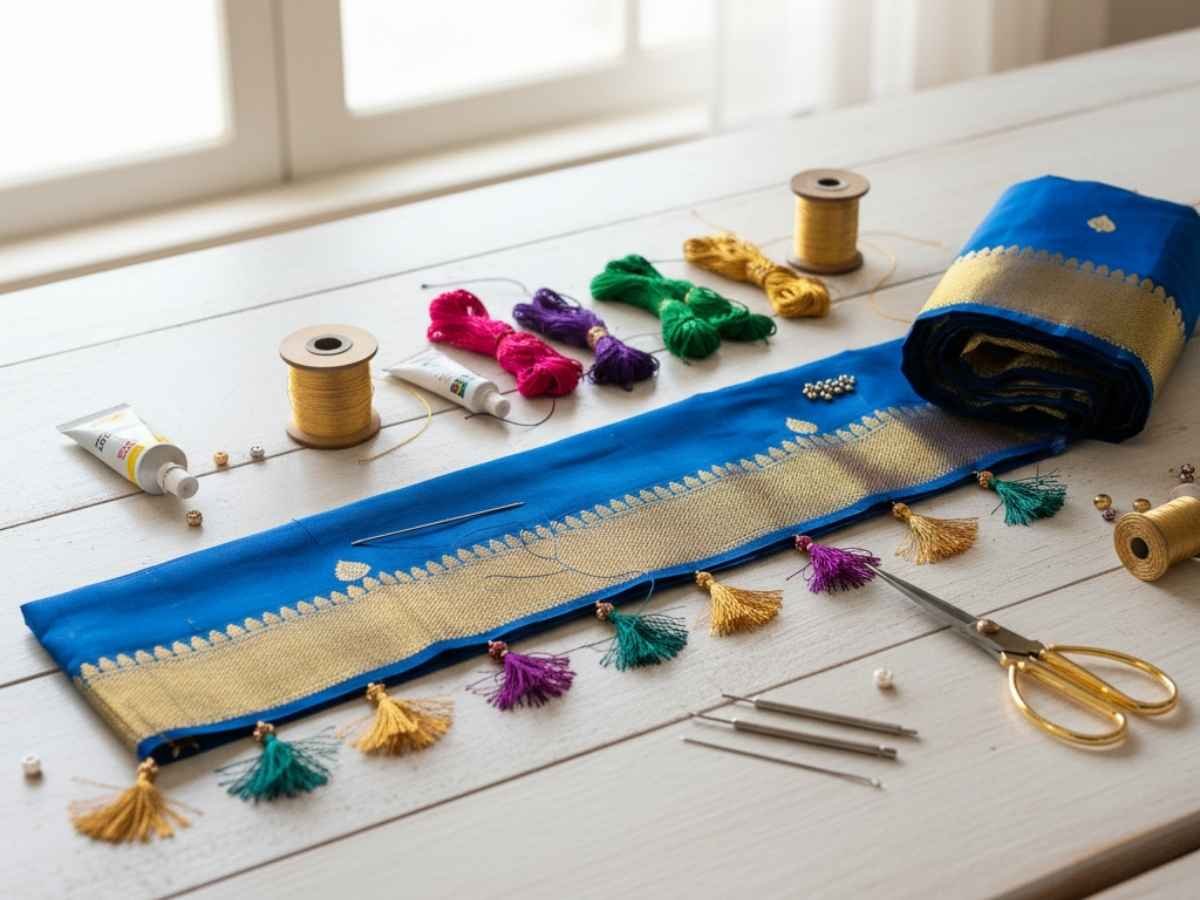How to make Baby Kuchu using silk thread is one of the most popular and traditional ways to finish a saree border beautifully. This single-step Baby Kuchu design is easy to learn, elegant in appearance, and perfect for both Kanjeevaram and cotton sarees.
In this tutorial, you’ll learn everything from required materials to the exact steps needed to create neat, symmetrical tassels. Even if you’re a beginner, this guide will help you achieve a professional finish at home.
What is Baby Kuchu?
Baby Kuchu is a short and thick tassel design tied along the saree border to enhance its beauty. It’s an ancient South Indian art form used to decorate sarees for festive and bridal occasions.
This particular 1-step Baby Kuchu design is simple, elegant, and timeless — ideal for minimalists who prefer traditional beauty without beads or embellishments.
Tip: This design looks especially stunning when made with contrast silk thread or gold zari that matches your saree pallu.
Materials Required for Making Baby Kuchu
To make this design, you’ll need the following saree kuchu making materials:
- Silk Thread – For tassel making (use 100 strands).
- Zari Thread (Gold or Silver) – For shimmer and contrast.
- Big Eye Needle – Makes threading easy.
- Hemming Needle – For finer stitching if needed.
- Trimmer or Scissors – To cut threads evenly.
- Fabric Glue – To secure tassel ends neatly.
- Cardboard/Notebook – To wrap and measure equal thread lengths.
- Hair Straightener – To iron strands for a smooth finish.
Pro Tip: Always use gold zari that has thread inside, not wire, for durability and better flexibility.
Step-by-Step Tutorial: How to Make Baby Kuchu Using Silk Thread
Follow these easy steps to make a professional-quality Baby Kuchu at home.
Step 1 – Prepare the Thread Bunch
- Take silk thread rolls and wrap them around a cardboard or long notebook 100 times.
- Cut at one end to create equal-length strands.
- Iron gently using a hair straightener to remove bends.
Step 2 – Create the Base Knot
- Take 6 strands of zari or 8 strands of silk thread for the base.
- Tie a firm knot at the saree’s edge to anchor your tassel.
- Make sure it’s tight and symmetrical.
Step 3 – Attach the Tassel Bunch
- Fold your prepared bunch in half and place it behind the saree edge.
- Use a big eye needle to insert the bunch securely.
- Adjust the tassel evenly on both sides.
Step 4 – Secure and Finish
- Use a hemming needle to reinforce the knot.
- Trim all tassels to equal length with a trimmer.
- Apply a drop of fabric glue to the knot for long-lasting hold.
- Iron once more lightly for a professional finish.
Watch the full tutorials on our Knotty Threadz YouTube Channel
Points to Remember
- Use at least 100 strands of silk thread for rich thickness.
- Always trim tassels evenly after tying.
- Use thread-based zari instead of metallic wire.
- Iron the tassel bunch before and after tying for neat results.
- Experiment with contrast color combinations to match saree pallus.
Variations You Can Try
- Single Color Baby Kuchu – Simple and classic.
- Dual Color Kuchu – For a vibrant, festive appeal.
- Zari Baby Kuchu – Adds shimmer to bridal sarees.
- Without Big Eye Needle – Use a folded thread method if needle unavailable.
These variations can also be used for dupattas, stoles, lehengas, and handmade home décor like curtain tiebacks.
Quick Summary
| Element | Details |
|---|---|
| Design Type | One-Step Baby Kuchu |
| Main Material | Silk Thread |
| Difficulty Level | Beginner-Friendly |
| Best For | Kanjeevaram, Cotton, Linen Sarees |
| Time Required | 30–45 minutes per saree |
| Pro Tip | Always iron the strands before trimming for uniformity |
FAQs
Q1. How many strands are required for making Baby Kuchu?
Use a minimum of 100 strands of silk thread for a dense, professional look.
Q2. Can I make Baby Kuchu without a Big Eye Needle?
Yes, you can use a folded thread or bobby pin method for threading tassels easily.
Q3. What type of zari should I use?
Use thread-based zari (not wire) for durability and smooth finishing.




